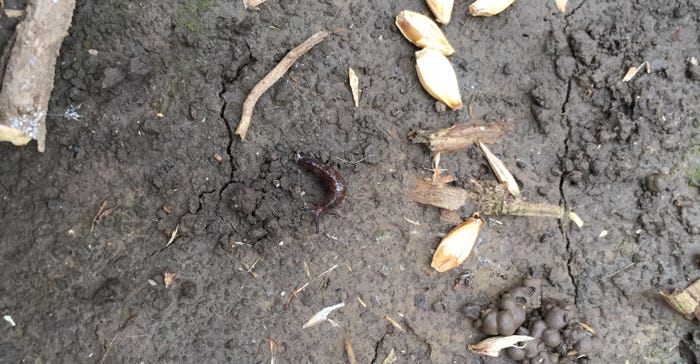January 9, 2017

Slugs are becoming increasingly problematic for Wisconsin farmers. A warm winter combined with a wet summer and fall has increased slug survival, which in turn has increased the amount and types of slug damage to crops. Slugs need a moist environment to live and prefer heavy residue — so conservation-tillage and cover-cropped fields and fields with heavy soils have been the most affected.
2 types of slugs
Two types of slugs are prevalent in Wisconsin crop fields. The gray field slug (pictured above) is a light gray or brown and is about an inch long. The marsh slug (below) is dark brown and only about a half inch long.

MARSH SLUG: The marsh slug is dark brown and about a half inch long.

Slugs are nocturnal feeders, so to find them during the day, growers need to scout under residue or soil clods. Another way to find out if there are slugs in a field is to leave a piece of cardboard or wood out in the field overnight. If slugs are present, they will be hiding on the underside of the board the next day.
Slugs feed on a wide range of plants, including many crop plants. They feed by scraping the surface off of their food, leaving characteristic window-paned feeding patterns on leaves. Slug feeding can kill young seedlings or set back older seedlings. Slug feeding is particularly devastating in soybeans, where feeding on young seedlings can quickly kill the young plant and greatly reduce stands.
In central Wisconsin this past summer, slugs were also found to have fed on the brace roots of corn, causing lodging. We haven’t seen these types of late-season issues from slugs in the past, and I hope this was just a symptom of an abundant slug population and not a sign of future problems.
Slugs also feed on seeds, both of crop plants and cover crops. Slugs cannot feed on seeds that are covered with soil, so when planting corn and soybeans, it is important to make sure the seed furrow is closing during planting.
Slugs have become a huge problem for farmers who plant cover crops by broadcasting the seed. They feed on the germ end of rye, triticale and even barley and oat seeds, destroying the cover crops before they can germinate. In fields with heavy slug populations in which farmers would like to use cover crops, farmers should drill or work the seed in rather than broadcast it on the soil surface. Slugs have also been found to feed on radishes used as cover crops, potentially increasing problems with the following cash crop.
Managing slugs is not a simple task. They are not an insect, so insecticides are ineffective. In fact, insecticides may actually increase slug problems by killing insects that feed on slugs, such as ground beetles. Molluscicides applied as baits, such as metaldehyde (Deadline products) and iron EDTA (Iron Fist) can be effective but may not be cost-effective, particularly with low crop prices. (Metaldehyde is not labeled for use in soybeans in Wisconsin.) These products can also be washed away with significant rains. Farmers may choose to spot-treat particularly problematic areas, but molluscicides are likely not practical for large-scale use.
Tillage can be effective in reducing slug populations by burying residue, drying and warming the soil, and destroying slugs. However, for farmers dedicated to reduced-tillage systems or who cannot use tillage due to their conservation plan, this may not be a viable option. Using row cleaners, trash whippers or strip tillage can also be helpful in reducing slug damage by keeping the residue away from the emerging crop. Early planting may help give the crop a head start prior to the greatest period of slug hatching, but this is only practical if weather conditions are conducive.
Killing slugs
Growers and researchers are exploring some newer management practices as slug problems have increased across the U.S. One of these practices is spraying nitrogen at night, during the period of slug activity. The salt content of the fertilizer spray kills the slugs. Penn State slug researcher John Tooker recommends about 30% N mixed in a 1-to-1 ratio with water, sprayed three nights in a row at 3 a.m. He believes the treatment kills about a third of the population every night, so three applications are needed. Research in small plots estimates this protocol reduced the slug population by 75%. However, this program would need to be compatible with the grower’s nutrient management plan.
Penn State research has also found that cover crops grown with cash crops reduce slug damage on the cash crops by providing an alternative food source for the slugs. However, research is still ongoing to determine the best management recommendations for interseeding cover crops. Cover crops can compete with cash crops and reduce yield if not managed correctly.
Slugs will likely become a greater problem in production systems in years to come, potentially thwarting efforts to increase adoption of conservation practices. More research is needed to develop better management strategies for this slimy pest.
Johnson is the Dane County Extension crops and soils agent. Contact her at [email protected] or 608-224-3716, or Bryan Jensen, University of Wisconsin Extension entomologist, at [email protected] or 608-263-4073 for more information.
About the Author(s)
You May Also Like




